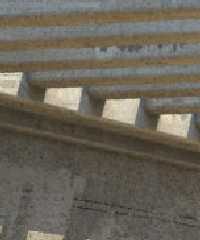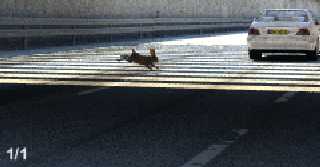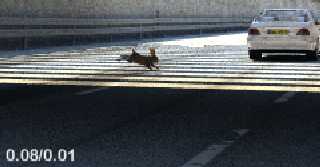 |
 |
|
 |
|
 |
|  |
|  |
|
 |
|
 |
|  |
|  |
|
 |
Jaime Vives Piqueres wrote:
>
> But, if so, how Gilles radiosity scenes look so nice? I my self tried
> just now pretrace start and end to 1 with my current irtc entry, and the
> result is a 30% faster than with the recommended settings.
Of course it's faster, but is it better? It would be really nice to see
some samples for comparison.
There is also the opposite approach BTW:
low pretrace_end, always_sample off and using save_file / load_file.
> And,
> strangely, the result seems to be more "natural" although it has some
> artifacts. Perhaps for "dirty" scenes it adds some irregularity that
> looks better to our "anti-perfectly-clean" minds. In any case, I would
> stick to 1 at least for that concrete scene, cause it renders faster and
> the result looks slightly better.
I always find this kind of 'dirt' quite confusing and unnatural. NTL, if
you have a nice example showing this effect i would be eager to see it.
Christoph
--
Christoph Hormann <chr### [at] gmx de>
IsoWood include, radiosity tutorial, TransSkin and other
things on: http://www.schunter.etc.tu-bs.de/~chris/ de>
IsoWood include, radiosity tutorial, TransSkin and other
things on: http://www.schunter.etc.tu-bs.de/~chris/
Post a reply to this message
|
 |
|  |
|  |
|
 |
|
 |
|  |
|  |
|
 |
> Of course it's faster, but is it better? It would be really nice to see
> some samples for comparison.
Well, at least the increased time seems to not justify the little
quality added. I don't want to show my current entry now, but at the end
of the round I will post both versions.
> I always find this kind of 'dirt' quite confusing and unnatural. NTL, if
> you have a nice example showing this effect i would be eager to see it.
I've substracted both images and the difference is not really visible.
I had to highly increase bright and contrast on the differenced image
to see which zones changed. At the eye, the only visible difference is
the behavoir of layered textures. With pretrace=1 it seems more like
without radiosity, while with the recommended setting the layers seems
to "blend" (obviously that must happen bcos more rays come trough,
isn't?), making the texture strange. Perhaps the problem is that we must
create the layered textures thinking on the later use of radiosity...
--
Jaime Vives Piqueres
La Persistencia de la Ignorancia
http://www.ignorancia.org/
Post a reply to this message
|
 |
|  |
|  |
|
 |
|
 |
|  |
|  |
|
 |
Jaime Vives Piqueres wrote:
> But, if so, how Gilles radiosity scenes look so nice? I my self tried
> just now pretrace start and end to 1 with my current irtc entry, and the
> result is a 30% faster than with the recommended settings. And,
> strangely, the result seems to be more "natural" although it has some
> artifacts.
To be frank, it's very confusing. I just tested this and the truth is that I
don't have a proper answer. In one little test scene, using Christoph's rad
"IndoorHQ" settings, using pretrace values <1 is better than pretrace 1
values : slightly lower rendering times, slightly less artifacts (but
artifacts nonetheless).
Now I'm sure to have experienced the same speed boost as you just noticed,
which is why I've been using these settings for almost a year with no
visible problems (I think that it was Xplo who found this trick). Note that
this could also explain why I don't have artifacts when I stop and resume
radiosity scenes (something I've been doing systematically to save memory,
even with 640 Mb of RAM).
I guess we should test this on full scenes. I just launched one of these
(800*320) with pretrace activated, and will render it again without. I
should have some answers on Saturday...
G.
--
**********************
http://www.oyonale.com
**********************
Graphic experiments
Pov-ray gallery
Post a reply to this message
|
 |
|  |
|  |
|
 |
|
 |
|  |
|  |
|
 |
Jaime Vives Piqueres wrote:
>
> Well, at least the increased time seems to not justify the little
> quality added. I don't want to show my current entry now, but at the end
> of the round I will post both versions.
>
I have done some quick tests myself, not as valuable as testing in a real
scene, but it shows the effect in different situations:
http://www.schunter.etc.tu-bs.de/~chris/rad/radiosity_pretrace.html
Note that the times given are not extremely accurate.
It seems that in some situations differences in both quality and speed are
quite low, in other cases it's much faster without pretrace, but also much
lower quality.
What seems interesting to me is that in the first sequence (without light
sources) the 'medium settings' (last picture) give the best quality of all
the three cases.
Christoph
--
Christoph Hormann <chr### [at] gmx de>
IsoWood include, radiosity tutorial, TransSkin and other
things on: http://www.schunter.etc.tu-bs.de/~chris/ de>
IsoWood include, radiosity tutorial, TransSkin and other
things on: http://www.schunter.etc.tu-bs.de/~chris/
Post a reply to this message
|
 |
|  |
|  |
|
 |
|
 |
|  |
|  |
|
 |
Gilles Tran wrote:
>
> Jaime Vives Piqueres wrote:
>
> > But, if so, how Gilles radiosity scenes look so nice? I my self tried
> > just now pretrace start and end to 1 with my current irtc entry, and the
> > result is a 30% faster than with the recommended settings. And,
> > strangely, the result seems to be more "natural" although it has some
> > artifacts.
>
> To be frank, it's very confusing. I just tested this and the truth is that I
> don't have a proper answer. In one little test scene, using Christoph's rad
> "IndoorHQ" settings, using pretrace values <1 is better than pretrace 1
> values : slightly lower rendering times, slightly less artifacts (but
> artifacts nonetheless).
> Now I'm sure to have experienced the same speed boost as you just noticed,
> which is why I've been using these settings for almost a year with no
> visible problems (I think that it was Xplo who found this trick). Note that
> this could also explain why I don't have artifacts when I stop and resume
> radiosity scenes (something I've been doing systematically to save memory,
> even with 640 Mb of RAM).
> I guess we should test this on full scenes. I just launched one of these
> (800*320) with pretrace activated, and will render it again without. I
> should have some answers on Saturday...
It's been a while since I actually messed with pretrace parameters, but
IIRC, error_bounds > .1 benefit visually from a really precise pretrace
(although above .4 or so, the benefit may not be worth the time anyway),
whereas smaller error_bounds don't, so pretrace should be set to 1 to
save time. Don't take this as absolute gospel, though; these are
approximations off the top of my head, and not based on extensive testing.
It's worth pointing out that the messier your scene naturally is (due to
texturing, or objects casting a lot of small shadows, or something), the
less perfect your radiosity has to be. Those of you who like making
radiosity scenes where everything is apparently made out of smooth gray
plastic might do well to keep that in mind...
-Xplo
Post a reply to this message
|
 |
|  |
|  |
|
 |
|
 |
|  |
|  |
|
 |
Xplo Eristotle wrote:
> It's been a while since I actually messed with pretrace parameters, but
> IIRC, error_bounds > .1 benefit visually from a really precise pretrace
> (although above .4 or so, the benefit may not be worth the time anyway),
> whereas smaller error_bounds don't, so pretrace should be set to 1 to
> save time. Don't take this as absolute gospel, though; these are
> approximations off the top of my head, and not based on extensive testing.
My feeling too. My rule of thumb would be like this:
[1] test renders with no quality requirement : pretrace 1 (saves time)
[2] final renders with error_bound < 0.1 : pretrace 1 (saves time)
[3] all other types of radiosity renders : small pretrace values may save time
and improve quality
BTW, I was too optimistic about my current test renders as the first one (with
pretrace<1) is crawling at 150 points per minute. No answers (checking rule [2])
until next Monday at best.
> It's worth pointing out that the messier your scene naturally is (due to
> texturing, or objects casting a lot of small shadows, or something), the
> less perfect your radiosity has to be.
This is true, and particularly for flat surfaces. However, in my experience, small
error_bound values are always needed to get accurate shadows below objects placed
in radiosity-lit areas.
G.
--
**********************
http://www.oyonale.com
**********************
Graphic experiments
Pov-ray gallery
Post a reply to this message
Attachments:
Download 'periphdetail6.jpg' (16 KB)
Preview of image 'periphdetail6.jpg'

|
 |
|  |
|  |
|
 |
|
 |
|  |
|  |
|
 |
Gilles Tran wrote:
>
> Xplo Eristotle wrote:
>
> > It's worth pointing out that the messier your scene naturally is (due to
> > texturing, or objects casting a lot of small shadows, or something), the
> > less perfect your radiosity has to be.
>
> This is true, and particularly for flat surfaces. However, in my experience, small
> error_bound values are always needed to get accurate shadows below objects placed
> in radiosity-lit areas.
Yeah, but you can at least reduce the count if the artifacts won't be noticed.
-Xplo
Post a reply to this message
|
 |
|  |
|  |
|
 |
|
 |
|  |
|  |
|
 |
Gilles Tran wrote:
>
> Xplo Eristotle wrote:
>
> > It's been a while since I actually messed with pretrace parameters, but
> > IIRC, error_bounds > .1 benefit visually from a really precise pretrace
> > (although above .4 or so, the benefit may not be worth the time anyway),
> > whereas smaller error_bounds don't, so pretrace should be set to 1 to
> > save time. Don't take this as absolute gospel, though; these are
> > approximations off the top of my head, and not based on extensive testing.
>
> My feeling too. My rule of thumb would be like this:
> [1] test renders with no quality requirement : pretrace 1 (saves time)
> [2] final renders with error_bound < 0.1 : pretrace 1 (saves time)
> [3] all other types of radiosity renders : small pretrace values may save time
> and improve quality
>
I have made some more test renders, available on the URL posted in the
other subthread. The differences in speed are quite marginal and the
quality differences seem to diminish with lower error_bound, just like
Xplo said.
Christoph
--
Christoph Hormann <chr### [at] gmx de>
IsoWood include, radiosity tutorial, TransSkin and other
things on: http://www.schunter.etc.tu-bs.de/~chris/ de>
IsoWood include, radiosity tutorial, TransSkin and other
things on: http://www.schunter.etc.tu-bs.de/~chris/
Post a reply to this message
|
 |
|  |
|  |
|
 |
|
 |
|  |
|  |
|
 |
Gilles Tran wrote:
> BTW, I was too optimistic about my current test renders as the first one (with
> pretrace<1) is crawling at 150 points per minute. No answers (checking rule [2])
> until next Monday at best.
Much too optimistic... The second render just finished. The comparison was between a
pretrace_start/pretrace_end =1/1 render and a 0.08/0.01 one.
Note that the experiment was not scientific, because Povray was running in the
background with a low priority while I working with other CPU-consuming apps
(databases) during half of the renders. I also had to make a slight change on a
texture between the two renders (I guess with no effect on the render time).
- identical render times : 27h 46 min
- substracting the image shows some little differences (in the parts not touched by
the texture change) but final appearance could be said identical apart one
antialiasing problem with the 0.08/0.01 image.
Other rad params were :
count 400
error_bound 0.05
nearest_count 4
recursion_limit 1
low_error_factor 1
gray_threshold 0.15
minimum_reuse 0.015
brightness 1.5
adc_bailout 0.01/2
normal on
Attached: two PNG (extracts of the final images) of 58 kbu each.
G.
--
**********************
http://www.oyonale.com
**********************
Graphic experiments
Pov-ray gallery
Post a reply to this message
Attachments:
Download 'periph2.png' (58 KB)
Download 'periph1.png' (58 KB)
Preview of image 'periph2.png'

Preview of image 'periph1.png'

|
 |
|  |
|  |
|
 |
|
 |
|  |
|  |
|
 |
AWESOME ROLEX! No really I can't believe this is rendered. Perhaps part of
it is the small size of the picture but I still say that is unbelievably
realistic.
"Gilles Tran" <tra### [at] inapg inra inra fr> wrote in message
news:3B6914F7.5D8E369A@inapg.inra.fr...
> Gilles Tran wrote:
>
> > BTW, I was too optimistic about my current test renders as the first one
(with
> > pretrace<1) is crawling at 150 points per minute. No answers (checking
rule [2])
> > until next Monday at best.
>
> Much too optimistic... The second render just finished. The comparison was
between a
> pretrace_start/pretrace_end =1/1 render and a 0.08/0.01 one.
> Note that the experiment was not scientific, because Povray was running in
the
> background with a low priority while I working with other CPU-consuming
apps
> (databases) during half of the renders. I also had to make a slight change
on a
> texture between the two renders (I guess with no effect on the render
time).
>
> - identical render times : 27h 46 min
> - substracting the image shows some little differences (in the parts not
touched by
> the texture change) but final appearance could be said identical apart one
> antialiasing problem with the 0.08/0.01 image.
>
> Other rad params were :
> count 400
> error_bound 0.05
> nearest_count 4
> recursion_limit 1
> low_error_factor 1
> gray_threshold 0.15
> minimum_reuse 0.015
> brightness 1.5
> adc_bailout 0.01/2
> normal on
>
> Attached: two PNG (extracts of the final images) of 58 kbu each.
>
> G.
>
>
>
> --
>
> **********************
> http://www.oyonale.com
> **********************
> Graphic experiments
> Pov-ray gallery
>
>
----------------------------------------------------------------------------
----
----------------------------------------------------------------------------
---- fr> wrote in message
news:3B6914F7.5D8E369A@inapg.inra.fr...
> Gilles Tran wrote:
>
> > BTW, I was too optimistic about my current test renders as the first one
(with
> > pretrace<1) is crawling at 150 points per minute. No answers (checking
rule [2])
> > until next Monday at best.
>
> Much too optimistic... The second render just finished. The comparison was
between a
> pretrace_start/pretrace_end =1/1 render and a 0.08/0.01 one.
> Note that the experiment was not scientific, because Povray was running in
the
> background with a low priority while I working with other CPU-consuming
apps
> (databases) during half of the renders. I also had to make a slight change
on a
> texture between the two renders (I guess with no effect on the render
time).
>
> - identical render times : 27h 46 min
> - substracting the image shows some little differences (in the parts not
touched by
> the texture change) but final appearance could be said identical apart one
> antialiasing problem with the 0.08/0.01 image.
>
> Other rad params were :
> count 400
> error_bound 0.05
> nearest_count 4
> recursion_limit 1
> low_error_factor 1
> gray_threshold 0.15
> minimum_reuse 0.015
> brightness 1.5
> adc_bailout 0.01/2
> normal on
>
> Attached: two PNG (extracts of the final images) of 58 kbu each.
>
> G.
>
>
>
> --
>
> **********************
> http://www.oyonale.com
> **********************
> Graphic experiments
> Pov-ray gallery
>
>
----------------------------------------------------------------------------
----
----------------------------------------------------------------------------
----
Post a reply to this message
|
 |
|  |
|  |
|
 |
|
 |
|  |
|
 |




![]()